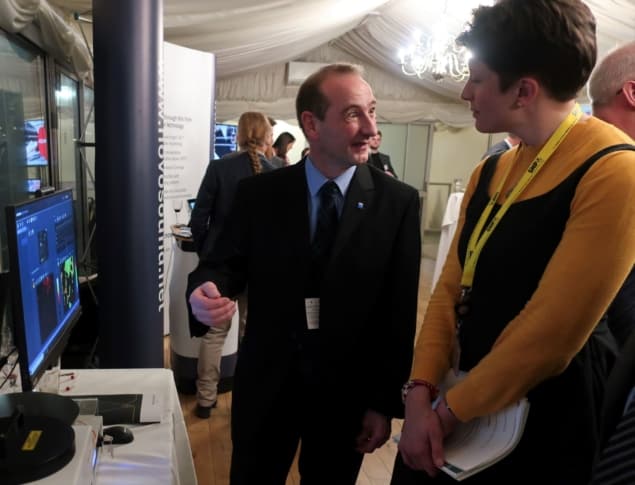
Innovative biomedical imaging systems and advanced engine components received top billing in the annual Institute of Physics (IOP) Business Innovation Awards, which honour companies for developing new products based on creative applications of physics.
At a ceremony held on 17 October in London’s House of Commons, representatives from the winning firms presented their work to members of parliament and luminaries from the UK science and business communities. The devices on show in the crowded riverside pavilion included Aeristech’s compressor for hydrogen fuel-cell cars; Elekta’s integrated MRI scanner/linear accelerator for targeted radiotherapy; FFEI’s high-resolution scanner for tissue samples; Horiba’s “molecular movie camera” for fluorescence imaging; and Reaction Engines’ heat exchanger for an air-breathing rocket engine. Four start-up firms – Matoha Instrumentation, Novosound, Opsydia and VeriVin – also received separate awards for products at an earlier stage of development.
During the ceremony, the awards’ parliamentary sponsor, Alok Sharma MP, paid special tribute to VeriVin, whose founder Cici Muldoon translated her PhD research in atomic and molecular physics into a spectroscopic analyser for wine and other complex liquids. Thanks to VeriVin’s system, Sharma enthused, “if you order a bottle of ’89 Bordeaux and you get a ’91 instead, you can send it back” – a comment he followed with a hasty assurance that he, personally, consumes wine only in moderation. Seven other parliamentarians, including shadow minister for science and innovation Chi Onwurah and physics-teacher-turned-MP Carol Monaghan, also took a break from the day’s Brexit debates to congratulate the winners and learn more about their devices.
One of the evening’s honourees was Mike Woodroffe, a physicist who served as Aeristech’s chair and played a key role in developing its centrifugal compressors. These compressors use 40% less energy than conventional devices, and the first hydrogen fuel-cell cars to employ them are due to roll off the production line in China next year.

The second – very different – award-winning engine component on display was developed by Helen Webber and colleagues at Reaction Engines. Their heat exchanger can cool airstreams from 1000 °C to ambient temperatures in less than 1/20th of a second, making it a critical component of the firm’s Synergetic Air-Breathing Rocket Engine (SABRE). The exchanger is currently undergoing tests in the US, and Tom Page, the company’s public-relations chief, says they are on track to flight-test the completed SABRE in 2025.

The three biomedical winners each had to overcome unique design challenges. Elekta’s goal was to build a device that could image tumours in real time, while the patient is undergoing radiation treatment, so as to minimize radiation damage to healthy tissues and still deliver a clinically effective dose to the tumour. To accomplish this, Elekta physics research leader David Roberts explained that they first had to model how the magnetic field of their MRI scanner would interact with the electron beam of their linear accelerator. Once they understood that, they could then adapt their system’s magnets and shielding accordingly.

For FFEI’s device, the challenge was to help pathologists diagnose cancers and other conditions more quickly, without the eyestrain associated with regular, prolonged use of conventional microscopes. Their solution is a digital imaging system that keeps tissue samples in focus over the entire multi-millimetre area of a biopsy slide, while also preserving the colours that pathologists are accustomed to seeing in a microscope.
Horiba’s award-winning FLIMERA camera also has applications in cancer screening, but its underlying technology is based on fluorescence lifetime imaging microscopy (FLIM). Managing director David McLoskey described this technique as “a way of looking at stored energy in molecules”, adding that the length of time between when a molecule absorbs a photon and when it radiates the energy away is an important probe for interactions between cells and proteins. Horiba’s device incorporates advanced software that enables videos of molecular interactions to be displayed and recorded at a rate of 30 frames per second.

The IOP’s Business Awards are now in their eighth year. The list of past winners includes more than 50 companies from across the UK and Ireland, in sectors ranging from defence to food manufacturing.



